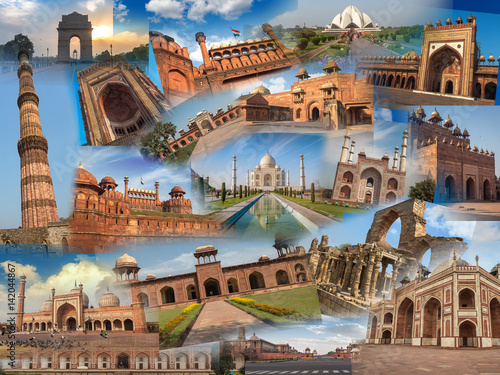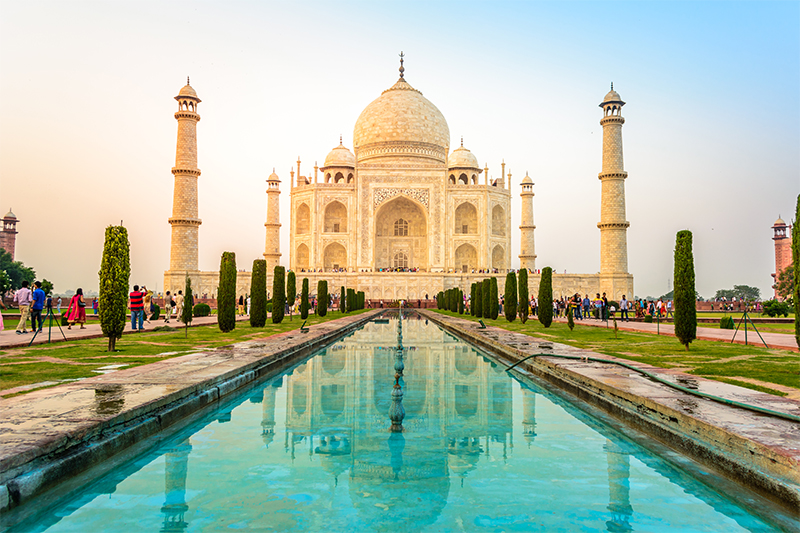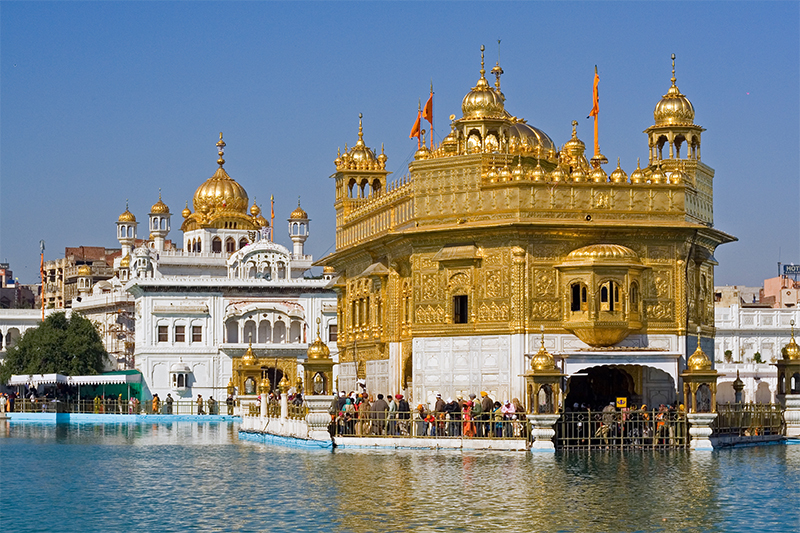TOP 5 FAMOUS MONUMENTS TO VISIT IN INDIA
Rich in culture and diversity, India is home to some of the finest historical monuments in the world. Most recognised by the UNESCO World Heritage Site, the famous Indian monuments include the beautiful Taj Mahal, the sacred Golden Temple and the cultural site, Hawa Mahal. Discover and experience the magnificent insights into India’s rich heritage and ancient architecture. Read on for our list of the top must see historical monuments in India below.Indian History is full of the rise and fall of many kingdoms and empires. Monuments, built y the kings and they perform of every period throw light on the past history of India. these monuments exhibit the glory of India and are part of our cultural heritage. Almost all states of India boast of some or the other important historical monuments. Thousands of tourists visit India to have a glimpse of its important historical places.

Taj Mahal, Agra
The Taj Mahal is an ivory-white marble mausoleum on the southern bank of the river Yamuna in the Indian city of Agra. It was commissioned in 1632 by the Mughal emperor Shah Jahan (reigned from 1628 to 1658) to house the tomb of his favourite wife, Mumtaz Mahal; it also houses the tomb of Shah Jahan himself. The tomb is the centrepiece of a 17-hectare (42-acre) complex, which includes a mosque and a guest house, and is set in formal gardens bounded on three sides by a crenellated wall.
The Taj Mahal was designated as a UNESCO World Heritage Site in 1983 for being "the jewel of Muslim art in India and one of the universally admired masterpieces of the world's heritage". It is regarded by many as the best example of Mughal architecture and a symbol of India's rich history. The Taj Mahal attracts 7–8 million visitors a year and in 2007, it was declared a winner of the New 7 Wonders of the World (2000–2007) initiative.
The Taj Mahal was designated as a UNESCO World Heritage Site in 1983 for being "the jewel of Muslim art in India and one of the universally admired masterpieces of the world's heritage". It is regarded by many as the best example of Mughal architecture and a symbol of India's rich history. The Taj Mahal attracts 7–8 million visitors a year and in 2007, it was declared a winner of the New 7 Wonders of the World (2000–2007) initiative.

Golden Temple (Harmandir Sahib), Amritsar
The holiest shrine and pilgrimage place located in Amritsar is The Golden Temple known as the Harmandir Sahib. This is the most famous and sacred Sikh Gurdwara in Punjab, India, adorned with rich history and gold gilded exterior. If you are interested in culture and history, be sure to visit this popular attraction in India.The Golden Temple is spiritually the most significant shrine in Sikhism. It became a center of the Singh Sabha Movement between 1883 and 1920s, and the Punjabi Suba movement between 1947 and 1966. In the early 1980s, the Gurdwara became a center of conflict between the Indian government led by Indira Gandhi, some Sikh groups and a faithful movement led by Jarnail Singh Bhindranwale seeking to create a new nation named Khalistan. In 1984, Indira Gandhi sent in the Indian Army as part of Operation Blue Star, leading to deaths of over 1,000 Sikh soldiers and civilians, as well as causing much damage to the Gurdwara and the destruction of Akal Takht. The Gurdwara complex was rebuilt again after the 1984 damage.

Meenakshi Temple, Madurai
Meenakshi Temple is situated on the Southern banks of Vaigai River in the temple city Madurai. This temple is dedicated to Parvati and her consort, Shiva and is visited by most Hindu and Tamil devotees and architectural lovers throughout the world. It is believed that this shrine houses 33,000 sculptures in its 14 gopurams. It’s no doubt one place to visit if you are impressed with art and cultural history.Madurai Meenakshi Sundareswarar temple was built by King Kulasekara Pandya (1190-1216 CE). He built the main Portions of the three-storeyed gopura at the entrance of Sundareswarar Shrine and the central portion of the Goddess Meenakshi Shrine are some of the earliest surviving parts of the temple. The traditional texts call him a poet-saint king, additionally credit him with a poem called Ambikai Malai, as well as shrines (koil) each for Natarajar and Surya near the main temple, Ayyanar in the east, Vinayagar in the south, Kariamalperumal in the west and Kali in the north. He also built a Mahamandapam.
Qutub Minar, New Delhi
Discover one of the tallest towers in the world and the second tallest Minar of India standing elegantly in the Capital city, New Delhi. Standing at 72.5 metres and consisting of around 379 stairs, this famous monument represents the rich architecture of India. As it is a UNESCO World Heritage Site made of red sandstone and decorated with Arabic and Brahmi inscriptions, travellers from around the world come to view this most famous tower in India.Before 1976, the general public was allowed access to the first floor of the minaret, via the internal staircase. Access to the top was stopped after 2000 due to suicides. On 4 December 1981, the staircase lighting failed. Between 400 and 500 visitors stampeded towards the exit. 47 were killed and some were injured. Most of these were school children.[20] Since then, the tower has been closed to the public. Since this incident the rules regarding entry have been stringent.
Sanchi Stupa, Sanchi
The beautiful and massive dome, Sanchi Stupa also known as the Great Stupa is a world renowned Buddhist monument in Sanchi, India. It was constructed by Emperor Ashoka, and is one of the oldest stone structures in the heart of India. Experience the Indian culture by visiting these major attractions in Sanchi including a number of Buddhist Stupas, monasteries and temples.Sanchi is the center of a region with a number of stupas, all within a few miles of Sanchi, including Satdhara (9 km to the W of Sanchi, 40 stupas, the Relics of Sariputra and Mahamoggallana, now enshrined in the new Vihara, were unearthed there), Bhojpur (also called Morel Khurd, a fortified hilltop with 60 stupas) and Andher , as well as Sonari (10 km SW of Sanchi).Further south, about 100 km away, is Saru Maru. Bharhut is 300 km to the northeast.The monuments at Sanchi today comprise a series of Buddhist monuments starting from the Maurya Empire period (3rd century BCE), continuing with the Gupta Empire period (5th century CE), and ending around the 12th century CE. It is probably the best preserved group of Buddhist monuments in India. The oldest, and also the largest monument, is the Great Stupa also called Stupa No. 1, initially built under the Mauryas, and adorned with one of the Pillars of Ashoka.



Comments
Post a Comment